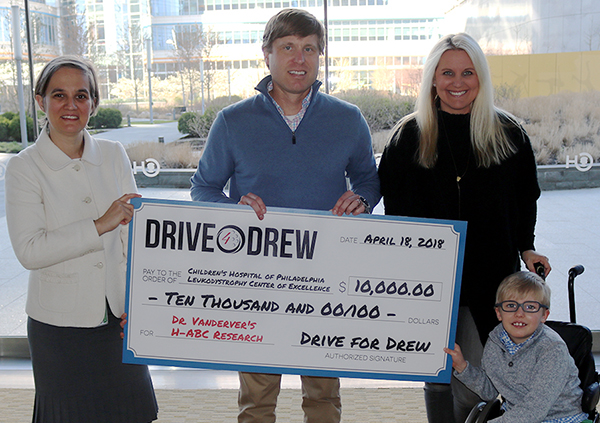HOW CAN WE HELP YOU? Call 1-800-TRY-CHOP
In This Section
Research Heroes: Drew Norton and Family Drive Leukodystrophy Research Forward
 It’s been a big year for 8-year-old Drew Norton and his family.
It’s been a big year for 8-year-old Drew Norton and his family.
Clinicians at the Children’s Hospital of Philadelphia Leukodystrophy Center diagnosed Drew with a rare genetic disorder nearly 12 months ago. Since then, Drew and his parents, Christy and Jason, have embarked on what they now call an “amazing run.” After years of misdiagnoses, they finally learned that Drew’s difficulties with movement and speech were caused by a specific leukodystrophy, a group of disorders that affects white matter in the brain. Though the Nortons are still learning more about the disorder and how best to manage it, the diagnosis has served as a baseline for a series of victories, both big and small.
Day by day, Drew has started to come out of his shell. With ongoing support from a leukodystrophy clinic in Atlanta, he seems less anxious when the family travels, more enthusiastic about the company of groups and other people, and eager to let his personality shine through. Drew also starred in a community-wide golf tournament, Drive 4 Drew, organized by the Norton’s family and friends last October in Watkinsville, Georgia, to support his progress and raise money for leukodystrophy research.
Raising over $32,000, the tournament’s success kick-started Christy and Jason’s desire to give back to the people and places who have supported them throughout the years. When they returned in April to CHOP for Drew’s annual check-in, they came bearing good news and a special gift for Drew’s doctor, Adeline Vanderver, MD, program director of the Leukodystrophy Center at CHOP: a check of $10,000 raised through Drive 4 Drew to support Dr. Vanderver’s leukodystrophy research.
“I know the way that we help Drew is to advance the research,” Christy Norton said. “And the way that we can advance both those efforts is by fundraising and having more participants in more studies, which leads to more data. That helps to find the issues and the problems in the disorder, and hopefully come up with some kind of treatment.”
Journey to a Diagnosis: The Beginning
Christy and Jason first began to notice red flags about one year after Drew’s birth, when he wasn’t reaching his developmental milestones. Taking Drew from one inconclusive test to another, they found themselves on a diagnostic odyssey familiar to parents whose children have a rare disease. At the age of 2, Drew was diagnosed with a mitochondrial disorder. At 5, he was diagnosed with cerebral palsy. After a dorsal rhizotomy surgery for cerebral palsy, Drew’s difficulties with his legs still kept returning.
Finally, Drew’s local neurologist suggested that he might have a leukodystrophy. Another round of genetic testing revealed a mutation in Drew’s TUBB4A gene, which is known to cause a type of leukodystrophy called hypomyelination with atrophy of the basal ganglia and cerebellum (H-ABC). The Nortons met with Dr. Vanderver at CHOP, who confirmed the H-ABC diagnosis and began to help the Nortons manage Drew’s symptoms.
“We’re eight years into this now, and only a year into the diagnosis, but getting the diagnosis helped me,” Christy said. “You can’t move forward if you don’t know.”
Dr. Vanderver added that when a family doesn’t have a diagnosis, “You don’t know what you’re fighting against.”
Boosting the Diagnostic Success Rate
Like other types of leukodystrophy, H-ABC is caused by a gene abnormality that affects the central nervous system by damaging the protective white matter, or myelin sheath, insulating nerve cells in the brain and spinal cord. As its name suggests, H-ABC targets two specific parts of the brain: the basal ganglia and the cerebellum, which control the body’s action and movement. Individuals with H-ABC often experience difficulties with their movement, speech, and development due to the disruption of myelin growth as well as gradual atrophy (or deterioration) of the basal ganglia and the cerebellum.
The features of H-ABC were first described by a group of researchers in the Netherlands, according to Dr. Vanderver. These researchers recognized that the disorder presented with a very specific pattern on magnetic resonance imaging, but they could not associate it with a specific gene. By collaborating with researchers in Australia, Dr. Vanderver and her research team were able to build on that knowledge and utilize novel genetic tests like whole exome sequencing (WES) to identify TUBB4A as the causative gene. This breakthrough, coupled with the development of even more powerful diagnostic tools such as whole genome sequencing (WGS) has allowed clinicians and researchers to identify even more patients with H-ABC.
Dr. Vanderver explains that broader genetic tests, now used clinically, coupled with data from families like the Nortons, have helped to increase the number and accuracy of leukodystrophy diagnoses in children. Prior to the introduction of these advanced genetic sequencing approaches, and in part because H-ABC’s features are often confused with cerebral palsy or other conditions, less than 50 percent of children with a leukodystrophy ever achieved a diagnosis. Now, as tools such as WES and WGS become more widely available, the diagnostic success rate in this patient population is approaching 80 percent.
“Since then, we’ve worked hard to understand how the change in the gene results in problems in certain cells, and we’re also working hard to understand the natural history,” Dr. Vanderver said. “And we’re very grateful to the families who are willing to come here because it helps us learn so much more. Our understanding of diseases like H-ABC is really made up of these individual data points that the families are generous enough to share.”
Connecting With the H-ABC Community for a Cure
Motivated to help scientists learn more about H-ABC and support other families find their way to a diagnosis, the Nortons enrolled in Dr. Vanderver’s H-ABC Natural History Study. This study collects medical records, blood samples, and survey responses of children and families affected by H-ABC, in order to better understand how the disease might progress across a range of individuals.
 “I don’t want parents to go through what we had to go through,” Christy said. “I would like there to be a better, quicker route to this diagnosis. I would like medical professionals across the board to have a better understanding of what this even is, so that parents don’t go through what we went through.”
“I don’t want parents to go through what we had to go through,” Christy said. “I would like there to be a better, quicker route to this diagnosis. I would like medical professionals across the board to have a better understanding of what this even is, so that parents don’t go through what we went through.”
The Nortons also continue to learn more about H-ABC by engaging with a support group on Facebook. This page allows Christy and Jason to communicate with families all over the world whose children have been affected H-ABC — even as far as Papua New Guinea. Though the group only has about 200 members (reflecting just how rare H-ABC is), it is extremely active and engaged, with new posts coming in every day. Even though one child with H-ABC can differ from another, the group still gives them a platform where they can talk openly with parents in the H-ABC community and ask each other questions.
“We can share things without having to explain everything,” Christy said. “We can just go straight to ‘What’s new?’, ‘What’s the latest research?’, ‘Has anybody heard anything?’ That makes a big difference for me.”
Settling Into a Year of Fun
Today, Drew is continuing what the Nortons call his “very fun year.” He’s loving his time with Extra Special People, an organization that pairs children and adults with disabilities with one-on-one buddies for swimming, camping, and other fun activities during the summer.
“Drew goes to summer day camp there right now, and they have beach trips with the families, and it’s just an amazing place,” Christy said. “It has been a big part of how great our year has been.”
Drew also loves trains and is thriving as the most popular kid in his class at school, where his classmates love to line up and give him hugs.
“All those things we worried about are the things we didn’t need to worry about,” Christy said. “School is great.”
And while managing Drew’s symptoms can sometimes be a challenge, Christy and Jason encourage families who might be going through any stage of their experience with a rare disease diagnosis to never lose perspective.
“From a father’s standpoint, I would say obviously pay attention to the science, pay attention to the doctors, but don’t lose focus of your child,” Jason said. “When you leave that doctor’s office, there’s still a kid who wants to, in Drew’s case, crawl around, be with his friends, and do social things. I think you can never totally push it out of the picture, but don’t let it get in between your relationship with your child.”
Learn more about Drive 4 Drew and H-ABC on the Facebook page.